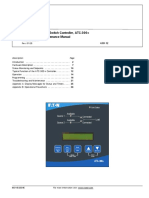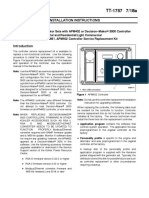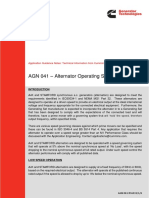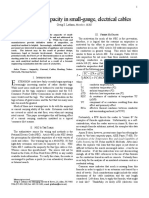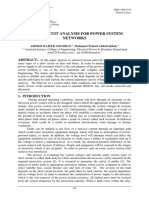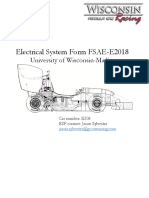MotorEffic&PF CM5
MotorEffic&PF CM5
Uploaded by
Alaa RamadanCopyright:
Available Formats
MotorEffic&PF CM5
MotorEffic&PF CM5
Uploaded by
Alaa RamadanCopyright
Available Formats
Share this document
Did you find this document useful?
Is this content inappropriate?
Copyright:
Available Formats
MotorEffic&PF CM5
MotorEffic&PF CM5
Uploaded by
Alaa RamadanCopyright:
Available Formats
ME 416/516
Motor Efficiency
and Power Factor
ME 416/516
Motivation
More than half of all electric energy generated
goes to power electric motors.
Electric motor converts electric power into shaft
power. In thermodynamics terms, this is simply
converting work from one form to another.
The Second Law allows electric motors to have
a theoretical efficiency of 100%.
In reality, several types of power loss occur from
where electricity leaves power plant to the point
where shaft power leaves the motor.
ME 416/516
Electric Power Losses
1. Transmission and transformer I
2
R and hysteresis
losses of real power component.
2. Transmission and transformer losses of
imaginary power component.
3. Losses in the motor resulting from winding
losses, frictional losses, etc.
Loss 1 can be reduced by transmitting power at
higher voltage: Power = VI and Loss = I
2
R.
Same power can be transmitted by increasing V
and reducing I: losses are reduced as 1/V
2
.
ME 416/516
Electric Power Losses (Contd)
Losses can also be reduced by decreasing R,
but this means larger conductors (heavier wire)
and copper is expensive.
Loss 2 can be reduced by lowering imaginary,
reactive part of current, which is accomplished
by power factor improvement, discussed next.
Loss 3 can be reduced by using more efficient
motors, where electric motor efficiency is
defined as:
= Shaft Power Out/Electric Power In
ME 416/516
Motor Ratings
An electric motors nameplate or rated power is
its output power, not its electric input power.
Electric power consumption is rated power
divided by motor efficiency.
Rated power depends on class of motor (which
considers intended duty). Industrial grade
motors usually are rated for continuous duty.
Motor efficiency requirements are set by 1992
Energy Policy Act (EPACT), primarily for larger
motors as used in industry and HVAC.
ME 416/516
1992 EPACT Selected Full-Load Motor
Efficiency Requirements
Open Motors Closed Motors
hp 2 pole 4 pole 6 pole 2 pole 4 pole 6 pole
1 --- 82.5 80.0 72.5 82.5 80.0
5 85.5 87.5 87.5 87.5 87.5 87.5
10 88.5 89.5 90.2 89.5 89.5 89.5
20 90.2 91.0 91.0 90.2 91.0 90.2
50 92.4 93.0 93.0 92.4 93.0 93.0
100 93.0 94.1 94.1 93.6 94.5 94.1
200 94.5 95.0 94.5 95.0 95.0 95.0
ME 416/516
Energy Savings through Electric
Motor Efficiency Improvement
EPACT was passed in 1992 but motor efficiency
provisions took effect in 1997.
Commercial, institutional and, particularly,
industrial operations use substantial amounts of
power for electric motors.
Although high or premium efficiencies may
have only a few percentage points better
efficiencies and may cost thousands of dollars
more, they often are good investments.
ME 416/516
Example- Elevator Motor
An elevator in an Orange Beach condominium lifts
an elevator weighing 5500 lbf at a rate of 5 ft/s. The
elevator operates 7 hr/day in APCo summer months
and 3 hr/day in winter months using an 85% efficient
motor installed when the condo was built. Consider
a replacement 95% efficient Baldor Super-E motor
costing $3500 + $500 installation. Assuming an
interest rate of 4%, electricity inflation rate of 4%,
overall inflation rate of 2.5%, 40% tax rate, 5-yr
depreciation, a 10% tax credit and no salvage value,
does it make sense to change motors? The condo
is a APCo Rate LPM customer.
ME 416/516
Example (Contd)
See Elevator Example Excel Spreadsheet
ME 416/516
Power Factor Correction
Electrical loss 2 between power plant and useful
work output of motor was the transmission and
transformer I
2
R and hysteresis losses resulting
from the imaginary component of the power.
This loss applies whenever an imaginary
component is present- not just for motors.
Power factor (PF) correction can reduce loss by
reducing imaginary component magnitude.
PF correction is relatively simple and economical,
and often yields large energy and cost savings.
ME 416/516
What Is Power Factor?
The total power in units of kVA is given by:
kVA = Volts * Amps * (N
ph
)
1/2
* 10
-3
where Volts and Amps are the measured rms
voltage and current and N
ph
is the number of
phases (1 or 3).
The relation between total power, reactive power
and real power is shown in the "power triangle".
For AC service, total power is the
vector sum of the real power and
reactive (imaginary) power.
ME 416/516
Power Factor Triangle
Real Power (kW)
T
o
t
a
l
P
o
w
e
r
(
k
V
A
)
R
e
a
c
t
i
v
e
P
o
w
e
r
(
k
V
A
R
)
(
k
V
A
R
)
ME 416/516
Notes on Power Triangle
Imaginary component of power is due to
imaginary impedance elements in the load.
Pure resistors have no imaginary component, so
current and voltage are "in phase" if impedance
consists only of resistance elements.
Capacitance causes voltage to lead the current,
i.e., V reaches maximum before current (leading).
Inductive impedance causes current to lead
voltage, i.e., the voltage reaches maximum
behind current (lagging).
ME 416/516
Power Triangle Notes (Contd)
The cycle angle by which voltage leads or lags
behind the current is called the phase angle, .
By simple trigonometry of the power triangle, the
real component of power (in units of kW) is:
kW = kVA * cos
Cosine is the power factor(PF): PF = cos
Similarly, reactive power (in units of kVAR) is:
kVAR = kVA*sin
Also by the Theorem of Pythagoras:
kVA
2
= kW
2
+ kVAR
2
ME 416/516
Why IS PF Less than 1?
Many common uses of electricity have inductive
components of impedance that produce a lagging power
factor:
induction motors (AC)
power thyristors for DC motor control
transformers and voltage regulators
electric welding equipment
electric arc and induction furnaces
neon and fluorescent lights (ballasts)
ME 416/516
Why Worry About
PF < 1?
Because V is fixed, then I is
proportional to total power
(kVA), and kVA = kW/PF.
The larger phase angle between V and I, the
smaller PF, the larger kVA and, thus, the larger
the current the utility must send over its lines.
Larger I causes larger I
2
R losses and requires
utility to install larger conductors & transformers.
Although customer uses same real power, the
lower PF costs the utility more to provide it.
ME 416/516
Results of Low PF
It costs the utility more to deliver the same real
power to a customer with low power factor, so
utilities charge a higher rate for low PF, either:
a direct penalty-higher charge for lower power
factors levels (e.g., PF > 95%, no extra charge; 90
< PF < 95%, 5% surcharge; 85 < PF < 90%, 10%
surcharge, etc.
or charge per kVA rather than per kW (APCo).
The customer also has to buy larger wiring,
switches, transformers, etc., because of higher
current and kVA.
ME 416/516
How Can Low PF Be Improved?
Recall that capacitance and inductive elements
have the opposite effect on the phase angle
between voltage and current.
Inductors have negative imaginary impedances,
but capacitors have positive imaginary
impedances.
Capacitors can be added to the power circuitry
to increase PF, as described in the power
triangle diagram following:
ME 416/516
Real Power (kW)
O
l
d
k
V
A
S
y
s
t
e
m
k
V
A
R
(
N
e
w
k
V
A
R
)
N
e
w
k
V
A
kW
C
a
p
.
k
V
A
R
Old
New
ME 416/516
Capacitor Sizing
First step is to measure present (old) kVA and
PF, or get them from the power bill.
Calculate kW: kW = PF
old
* kVA
old
Calculate system kVAR
sys
:
Identify a target PF
new
.
Calculate the new kVA using target PFnew:
kVA
new
= kW/PF
new
2 2
old sys
kW kVA kVAR =
ME 416/516
Capacitor Sizing (Contd)
Calculate kVAR
new
once target PF
new
is
achieved:
kVAR
new
is the difference between kVAR
sys
and
the added capacitor's kVAR:
kVAR
new
= kVAR
sys
- kVAR
cap
So kVAR of the capacitors to be installed is:
kVAR
cap
= kVAR
sys
- kVAR
new
2 2
new new
kW kVA kVAR =
ME 416/516
Who Is Affected by PF
Concerns?
Most utilities only assess a penalty for low PF
for relatively large power users.
For example, to get rate LPL, APCo customers
must have a 1200 kVA minimum capacity (this
corresponds to a $200,000 per year power bill).
Consequently, most customers to whom PF
correction is most important are industrial or
large institutional customers (like UA).
Both categories have large portion of load made
up by power supplied to large electric motors
and to fluorescent and HID lighting.
ME 416/516
Location of Capacitors
Effective PF correction begins by installing
capacitors at largest motors first and then
adding capacitors as required at distribution
load centers.
Capacitors typically are not supplied to motors
rated less than 20 hp unless these are the
largest motors in service.
Capacitors are normally installed on the load
side of the motor starter so that they are
effective only when the motor is operating.
ME 416/516
Location of Capacitors (Contd)
For motors that reverse, jog, etc., or where motor
may at times be driven by the load (elevators,
cranes), capacitors are connected on supply line
side of motor controls with a separate switch.
Adding excess capacitance can result in
dangerous or damaging capacitor discharge
through motor windings after motor is shut off.
Capacitance must be controlled to match loads to
avoid large discharge through motors and to lower
PF from too much leading impedance.
ME 416/516
Correcting PF of an Individual
Motor
One set of following information is needed:
Nameplate hp, efficiency, PF
Nameplate hp, efficiency, voltage, full load
amps (FLA)
Nameplate PF, voltage, FLA
Measured PF, voltage, FLA
ME 416/516
Correcting PF of an Individual
Motor (Contd)
Get motor kW and kVA using these equations :
kW = hp * 0.746/effic. = kVA * PF
kVA = FLA * Voltage * (Nph)
1/2
* 10
-3
where N
ph
is the number of phases (1 or 3).
Find the required kVAR capacitor as shown
before.
ME 416/516
Example
Given: PF = 0.82 and motor with nameplate info
of 100 hp and 94% efficiency.
Find: Capacitor kVAR needed for Pf
new
= 0.96.
Soln: Calculate present power requirement:
kW = 0.746 kW/hp*100 hp/0.94 = 79.4 kW
Calculate present kVA
kVA
old
= 79.4/0.82 = 96.8 kVA
Calculate present (system) kVAR:
kVAR
sys
= (96.8
2
- 79.4
2
)
1/2
= 55.4 kVAR
ME 416/516
Example (Contd)
Calculate new kVA if PF = 0.96 is reached:
kVA
new
= 79.4 kW/0.96 = 82.7 kVA
Calculate combined kVAR after capacitor
added:
kVAR
new
= (82.7
2
- 79.4
2
)
1/2
= 23.1 kVAR
Find kVAR of the capacitor to be installed:
kVAR
cap
= 55.4 - 23.1 = 32.3 kVAR
The nearest standard size would be installed,
probably 30 kVAR. A larger std. capacitor than
actually needed would be avoided if PF 1
You might also like
- Operators Manual 3Document73 pagesOperators Manual 3Leandro Diaz MartinezNo ratings yet
- 03192005214235Document0 pages03192005214235Daniela Buse0% (2)
- 21-Light Remote Annunciator: Owner's ManualDocument12 pages21-Light Remote Annunciator: Owner's ManualpicoucrNo ratings yet
- Kohler RXT Transfer Switch Operation/Installation ManualDocument60 pagesKohler RXT Transfer Switch Operation/Installation ManualJamesNo ratings yet
- G220 Transfer SwitchDocument68 pagesG220 Transfer SwitchFred50% (2)
- Lakeshore MC-Operating-Manual-with-MP7650-2012 PDFDocument52 pagesLakeshore MC-Operating-Manual-with-MP7650-2012 PDFLeo BurnsNo ratings yet
- Kohler M340+ Service and Parts Manual PDFDocument154 pagesKohler M340+ Service and Parts Manual PDFTom Leonard100% (1)
- 0900 0301Document51 pages0900 0301Elaine ValdemirNo ratings yet
- Electro-Mechanical Elements of Lift TechnologyDocument28 pagesElectro-Mechanical Elements of Lift TechnologyFiorella Amer CarrNo ratings yet
- Voltage Drop Calculations - U.S FormulaDocument3 pagesVoltage Drop Calculations - U.S FormulaOsama_Othman01No ratings yet
- Operation: Industrial Generator SetsDocument48 pagesOperation: Industrial Generator SetsEgberto Pino GuerreroNo ratings yet
- Old Robonic 1979 Operating ManualDocument12 pagesOld Robonic 1979 Operating Manualrop703406No ratings yet
- TP 6799Document84 pagesTP 6799Roberto Sanchez Zapata100% (1)
- Robonic II Transfer SwitchDocument14 pagesRobonic II Transfer SwitchJod CadieuxNo ratings yet
- Installation: Industrial/Commercial/Residential Generator SetsDocument56 pagesInstallation: Industrial/Commercial/Residential Generator Setsgearhead1No ratings yet
- Kohler 20 RES Operation ManualDocument40 pagesKohler 20 RES Operation Manualhobermanb100% (2)
- ECU-9988N Cut Sheet 22JULY08 PDFDocument2 pagesECU-9988N Cut Sheet 22JULY08 PDFJosé David Barrios PadrónNo ratings yet
- EA448Document9 pagesEA448Orlando Velado100% (1)
- Service Manual: Detector /sentinel ControlsDocument121 pagesService Manual: Detector /sentinel ControlsAlex100% (1)
- Automatic Transfer Switch Controller, ATC-300+ Operation and Maintenance ManualDocument28 pagesAutomatic Transfer Switch Controller, ATC-300+ Operation and Maintenance ManualMP DieselNo ratings yet
- Manual Panel E PlusDocument36 pagesManual Panel E PlusRoberto Sanchez Zapata100% (1)
- Westinghouse Robotic ATS PDFDocument14 pagesWestinghouse Robotic ATS PDFLeo BurnsNo ratings yet
- ZenithParts O 1153AFDocument15 pagesZenithParts O 1153AFSteve ANo ratings yet
- NRDETECTORDocument61 pagesNRDETECTORAdan Moreno GomezNo ratings yet
- AGN 123 - Rotor Balancing: Application Guidance Notes: Technical Information From Cummins Generator TechnologiesDocument2 pagesAGN 123 - Rotor Balancing: Application Guidance Notes: Technical Information From Cummins Generator TechnologiesariwibowoNo ratings yet
- Intelli SW 250 TransferenciaDocument32 pagesIntelli SW 250 Transferenciajuanka209No ratings yet
- Installation Instructions: 1. Mini USB ConnectionDocument12 pagesInstallation Instructions: 1. Mini USB ConnectionChase GietterNo ratings yet
- Training On Permanent Magnt UnitsDocument208 pagesTraining On Permanent Magnt UnitsBrianHaze100% (3)
- ATC-300+ and ATC-800 Bypass Isolation Contactor Based ATS PDFDocument56 pagesATC-300+ and ATC-800 Bypass Isolation Contactor Based ATS PDFPILAR MARTINEZNo ratings yet
- AGN 009 - Bearing LifeDocument6 pagesAGN 009 - Bearing LifeariwibowoNo ratings yet
- Agc 4 MK II Parameter List 4189341273 UkDocument127 pagesAgc 4 MK II Parameter List 4189341273 UkYvetteNo ratings yet
- 70r2000D - ABB Zenith MX150 O&M Manual PDFDocument28 pages70r2000D - ABB Zenith MX150 O&M Manual PDFPablo espertNo ratings yet
- Owner's Manual: HTS "W" Type Automatic Transfer SwitchDocument28 pagesOwner's Manual: HTS "W" Type Automatic Transfer SwitchShakeem SandsNo ratings yet
- PCC 3200 Service ManualDocument44 pagesPCC 3200 Service ManualAshly JosephNo ratings yet
- TP-6694 ControllerDocument172 pagesTP-6694 ControllerKenroy Francis100% (1)
- TP 6834Document48 pagesTP 6834Brandon AtzNo ratings yet
- Manual Panel E Plus PDFDocument36 pagesManual Panel E Plus PDFroberto sanchezNo ratings yet
- DSE Guide To Synch Ron Is Ing and Load Sharing Part 2Document47 pagesDSE Guide To Synch Ron Is Ing and Load Sharing Part 2Lewis Nasilele100% (1)
- tp6113 Kohler GeneratorDocument160 pagestp6113 Kohler GeneratorVivek ThangamaniNo ratings yet
- DCU 305 R3 and R3 LT Installation ManualDocument44 pagesDCU 305 R3 and R3 LT Installation ManualmichaelfvNo ratings yet
- 71r3000 (Ref. HR 5097)Document40 pages71r3000 (Ref. HR 5097)payolin77No ratings yet
- Diagnostic Repair Manual Corepower Home Standby GeneradorDocument116 pagesDiagnostic Repair Manual Corepower Home Standby GeneradorProfesional19No ratings yet
- Generac QTS ManualDocument166 pagesGenerac QTS ManualChris MaytumNo ratings yet
- Manual EA20S CaterpillarDocument3 pagesManual EA20S CaterpillarHernán Peñafiel ReaNo ratings yet
- R438 Leroy-Somer AVRDocument2 pagesR438 Leroy-Somer AVRThomas Branley100% (2)
- PMG PDFDocument6 pagesPMG PDFrajan_2002eeeNo ratings yet
- Woodward Speed Control EPG 4024Document36 pagesWoodward Speed Control EPG 4024Kareem MamdouhNo ratings yet
- Deif Set-Up For Synchronising and LoadsharingDocument3 pagesDeif Set-Up For Synchronising and LoadsharingPierre Eyebe100% (1)
- TP 6744Document14 pagesTP 6744Roberto Sanchez ZapataNo ratings yet
- GAC Product Application GuideDocument247 pagesGAC Product Application GuideRaeedNo ratings yet
- Liebert NX UPS: Installation Manual-10-30kVA, 208V, 60HzDocument80 pagesLiebert NX UPS: Installation Manual-10-30kVA, 208V, 60HzUzziel MagueNo ratings yet
- Onan UR Generator Manual Pub 900 0150Document81 pagesOnan UR Generator Manual Pub 900 0150DakotaDigger67% (3)
- Cummins OTPC Series Operator ManualDocument132 pagesCummins OTPC Series Operator ManualCritical Infrastructure Group100% (1)
- FG Wilson Generator Set Operator & Maintenance Instruction ManualDocument71 pagesFG Wilson Generator Set Operator & Maintenance Instruction ManualPhillip Smith100% (1)
- Settings For Generator Sync-Check RelaysDocument4 pagesSettings For Generator Sync-Check Relaysabdulyunus_amirNo ratings yet
- Advanced Genset Controller: Installation InstructionsDocument22 pagesAdvanced Genset Controller: Installation InstructionsengjosewilkerNo ratings yet
- Dry Type Power Factor Correction Capacitors: Application ManualDocument18 pagesDry Type Power Factor Correction Capacitors: Application ManualososdeanNo ratings yet
- Generator Operation Curve ExplainDocument10 pagesGenerator Operation Curve ExplainThar LayNo ratings yet
- Power Factor CorrectionDocument13 pagesPower Factor Correctiondimple_bhanaNo ratings yet
- 45 16255 EE543 2015 1 1 1 Week 8 9Document25 pages45 16255 EE543 2015 1 1 1 Week 8 9Kristel Mae Hertz CastilloNo ratings yet
- Power Factor and P.F. CorrectionDocument4 pagesPower Factor and P.F. Correctionjdcom_inNo ratings yet
- CalculationsDocument2 pagesCalculationskhialzadaNo ratings yet
- Ds 266hsh Nsh-En 02 2011Document28 pagesDs 266hsh Nsh-En 02 2011Alaa RamadanNo ratings yet
- Dsd213 Electrical Load Calculation WorksheetDocument1 pageDsd213 Electrical Load Calculation WorksheetAlaa RamadanNo ratings yet
- 0 Electrical Load CalculationsDocument1 page0 Electrical Load CalculationsAlaa RamadanNo ratings yet
- 5.4. Electric Resistance ChartDocument1 page5.4. Electric Resistance ChartAlaa RamadanNo ratings yet
- Wiring and LLDocument10 pagesWiring and LLAlaa RamadanNo ratings yet
- Calculating Ampacity in Small-Gauge, Electrical Cables: Greig S. Latham, Member, IEEEDocument4 pagesCalculating Ampacity in Small-Gauge, Electrical Cables: Greig S. Latham, Member, IEEEAlaa RamadanNo ratings yet
- Calculating Electric Flux Through A Disk: Page 1 of 1 Masteringphysics 2.0: Problem Print ViewDocument1 pageCalculating Electric Flux Through A Disk: Page 1 of 1 Masteringphysics 2.0: Problem Print ViewAlaa RamadanNo ratings yet
- Ladder 2010Document2 pagesLadder 2010Alaa RamadanNo ratings yet
- Homework 03-Solutions PDFDocument11 pagesHomework 03-Solutions PDFElizabeth DouglasNo ratings yet
- AccuRay Sensors - DLPDocument136 pagesAccuRay Sensors - DLPRandika Sudarma100% (2)
- Project Report UpdatedDocument85 pagesProject Report Updatedatheena paulsonNo ratings yet
- Short Circuit AnalysisDocument12 pagesShort Circuit AnalysisSyed Atiq ur RehmanNo ratings yet
- Exploded View & Part ListDocument21 pagesExploded View & Part Listsonic8659No ratings yet
- University of Wisconsin Madison Electric 2018 ESF Submission 2Document47 pagesUniversity of Wisconsin Madison Electric 2018 ESF Submission 2Shubham JaniNo ratings yet
- DEUTZ Service Engine ElectronicDocument2 pagesDEUTZ Service Engine Electronicsalman arifNo ratings yet
- Thermo Scientific Ramsey Series 17: Belt Scale System For Conveyor Weighing of Bulk MaterialsDocument4 pagesThermo Scientific Ramsey Series 17: Belt Scale System For Conveyor Weighing of Bulk MaterialsFloyd Mejia GamarraNo ratings yet
- DPG409Document3 pagesDPG409samuelNo ratings yet
- OOIIrrad Software ManualDocument72 pagesOOIIrrad Software ManualalexlhhcasNo ratings yet
- Servicing IBM Systems X Servers II - Study GuideDocument154 pagesServicing IBM Systems X Servers II - Study GuideMircea GavrilaNo ratings yet
- Radion 8140 PDFDocument68 pagesRadion 8140 PDFJL RochaNo ratings yet
- Effect of Annealing On Forming FreeDocument6 pagesEffect of Annealing On Forming FreeAkrithi AkrithiNo ratings yet
- Generations of Computers & NetworksDocument10 pagesGenerations of Computers & NetworksAVICK BISWASNo ratings yet
- General Description: High-Speed CAN Transceiver With Standby ModeDocument27 pagesGeneral Description: High-Speed CAN Transceiver With Standby ModeAT VSNo ratings yet
- HCSTool User Manual R1.2Document65 pagesHCSTool User Manual R1.2leejill1979No ratings yet
- A0005267 - DS - Sounder DB5Document2 pagesA0005267 - DS - Sounder DB5Cường LêNo ratings yet
- Cedia AwardsDocument144 pagesCedia AwardsToday's TrendsNo ratings yet
- Sitrain Pcs 7 TrainingDocument27 pagesSitrain Pcs 7 TrainingRafaelNo ratings yet
- Dual N-Channel Enhancement Mode Phn210T Trenchmos TransistorDocument8 pagesDual N-Channel Enhancement Mode Phn210T Trenchmos TransistorCristian ViolaNo ratings yet
- EC-1 (2mark& 16 Mark)Document28 pagesEC-1 (2mark& 16 Mark)anon_59319771No ratings yet
- Test Report 4075887Document57 pagesTest Report 4075887aslamNo ratings yet
- Lecture 25 PDFDocument31 pagesLecture 25 PDFRachit ShahNo ratings yet
- Calculated Short Circuit BehaviourDocument5 pagesCalculated Short Circuit Behaviourramlijavier0% (1)
- Microwave Network AnalysisDocument17 pagesMicrowave Network AnalysisellisitoxNo ratings yet
- Call MangementDocument15 pagesCall Mangementjuli_nazNo ratings yet
- D4000 Duplex Printer PDFDocument2 pagesD4000 Duplex Printer PDFMike GudNo ratings yet
- University of Mumbai: CircularDocument5 pagesUniversity of Mumbai: CircularDhiraj Sanjay SinghNo ratings yet
- Medium Voltage Assembly Solutions: Overview Brochure - Integrated Power DistributionDocument16 pagesMedium Voltage Assembly Solutions: Overview Brochure - Integrated Power DistributionFrancisco TorresNo ratings yet




















